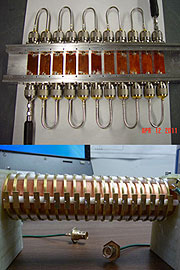The Project X chopper challenge
 |
|
Two Fermilab deflector prototypes being considered for the Project X chopper. In both cases, each rectangular copper plate sets up an electrostatic pulse that kicks the bunch farther and farther away from the beamline, chopping it out. |
At the recent Project X collaboration meeting, attendees confronted the proposed accelerator’s wide-band chopper, a system that would allow scientists to cherry-pick particle bunches from beams to be routed to multiple experiments.
Though its design is a formidable challenge, researchers now believe it’s a workable problem.
“The meeting was the first time we were confident there’s a solution,” said Steve Holmes, Project X project manager. “There are options that look like they’ll work.”
The chopper would lend the proposed Project X a kind of maneuverability not seen in other accelerators.
Different particle physics experiments call for different bunch patterns. A chopper helps create the required pattern by using electric fields to selectively pick off bunches from a steady stream of particles. Bunches in the beam that are left alone accelerate toward an experiment’s target.
With only one target, the chopper’s job can be straightforward: leave every nth bunch alone.
With more than one target, as in the case of Project X, the chopper has to send a far more complicated bunch pattern down the particle conveyor belt. It must also work in concert with a splitter, or router, to direct the right bunches to the different experiments.
“A chopper combined with a splitter is a new twist on the idea,” said Sergei Nagaitsev of Fermilab’s Accelerator Division. This new twist will give scientists the freedom to put in any pattern they like while efficiently serving up bunches for multiple experiments.
“We wanted the project to be as flexible as possible,” Nagaitsev said. “So this chopper is one of the strongest selling points for Project X.”
Collaborators from Fermilab, Lawrence Berkeley National Laboratory and SLAC are pursuing various technical options for the system.
“Nobody’s done anything like this before, but it’s the key to making the whole thing work,” Holmes said.
— Leah Hesla
|